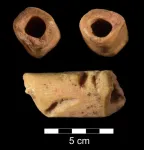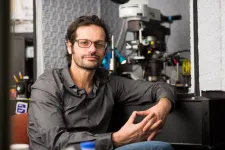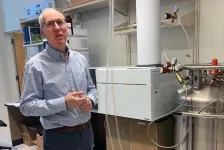(Press-News.org) University of Wyoming archaeology Professor Todd Surovell and his team of collaborators have discovered a tube-shaped bead made of bone that is about 12,940 years old.
The bead, found at the La Prele Mammoth site in Converse County, is the oldest known bead in the Americas.
Surovell’s research was published in the peer-reviewed journal Scientific Reports; the paper is titled “Use of hare bone for the manufacture of a Clovis bead.” Members of the research team included people from UW, the Office of the Wyoming State Archaeologist, the University of Manchester, Weber State University and Chico State University.
The La Prele Mammoth site preserves the remains of a killed or scavenged sub-adult Columbian mammoth and an associated camp occupied during the time the animal was butchered.
To determine the origin of the bone bead, the team extracted collagen for zooarchaeology by mass spectrometry, also known as ZooMS, which allowed the group to gain insights about the chemical composition of the bone.
The researchers concluded that the bead was made from either a metapodial (the bones that link the phalanges of the digits to the more proximal bones of the limb) or a proximal phalanx (a bone found in the fingers and toes of humans and other vertebrates) of a hare.
This finding represents the first secure evidence for the use of hares during the Clovis period, which refers to a prehistoric era in North America, particularly prominent about 12,000 years ago. It’s named after the Clovis archaeological site in New Mexico, where distinctive stone tools were discovered.
The bead is about 7 millimeters in length, and its internal diameter averages 1.6 millimeters. The research team considered the possibility that the bead could have been the result of carnivore consumption and digestion and not created by humans; however, carnivores were not common on this site, and the artifact was recovered 1 meter from a dense scatter of other cultural materials.
Additionally, the grooves on the outside of the bead are consistent with creation by humans, either with stones or their teeth. Beads like this one were likely used to decorate their bodies or clothing.
Surovell, who also directs UW’s Frison Institute, is an archaeologist with specialization in Paleoindian period, the earliest period of American archaeology. He has worked primarily in the Great Plains and Rocky Mountains but also has field experience in Eurasia. He is interested in factors that structure the archaeological record from decision-making to site formation.
END
Archaeologists discover oldest known bead in the Americas
2024-02-12
ELSE PRESS RELEASES FROM THIS DATE:
Interferon-gamma drives brain pathology in a mouse model of multiple system atrophy
2024-02-12
BIRMINGHAM, Ala. – Multiple system atrophy is a rare and fatal neurodegenerative disease, where insoluble inclusions of the protein alpha-synuclein appear in oligodendrocyte cells of the brain. The resulting pathogenesis features neuroinflammation, demyelination and neurodegeneration. Oligodendrocytes produce myelin, an insulating sheath on the axons of nerves.
In 2020, Ashley Harms, Ph.D., and University of Alabama at Birmingham colleagues published an Acta Neuropathologica study that used a mouse model to show that the ...
Drought may drive deadly amphibian disease, researchers find
2024-02-12
UNIVERSITY PARK, Pa. — Pumpkin toadlets are in trouble. Progressively severe droughts are disrupting the microbiomes of the thumbnail-sized orange frogs, potentially leaving them vulnerable to a deadly fungal disease, according to a new study by an international research team. The finding suggests that abnormal rainfall patterns, which are expected to worsen due to climate change and deforestation, may upset mutually beneficial relationships between wildlife and microorganisms, leading to biodiversity decline.
The researchers, led by Penn State doctoral ...
New study finds commonly used antibiotic is a cost-saving treatment for reducing maternal sepsis, death or infection in developing countries
2024-02-12
UNDER EMBARGO UNTIL: Feb. 12, 2024, 4:30 PM EST
Media Contacts: Karen Addis, APR, karen@addispr.com, +1 (301) 787-2394; Kerri Wade, MPA, kwade@smfm.org, +1 (202) 236-1780
National ...
Reshaping our understanding of granular systems
2024-02-12
Your morning cereal, a jar of nuts, the sands of distant planets, and even the concrete in your city are all examples of granular systems surrounding us. And such systems are harboring secrets that could change the way we mix things up.
In a new paper published in the journal Proceedings of the National Academy of Sciences (PNAS), scientists at the University of Rochester, including Rachel Glade, an assistant professor of earth and environmental sciences and of mechanical engineering; Fernando David Cúñez, a former postdoctoral research associate ...
Can hydrogels help mend a broken heart?
2024-02-12
You can mend a broken heart this valentine’s day now that researchers invented a new hydrogel that can be used to heal damaged heart tissue and improve cancer treatments.
University of Waterloo chemical engineering researcher Dr. Elisabeth Prince teamed up with researchers from the University of Toronto and Duke University to design the synthetic material made using cellulose nanocrystals, which are derived from wood pulp. The material is engineered to replicate the fibrous nanostructures and properties of human tissues, thereby recreating its unique biomechanical properties.
"Cancer is a diverse disease and two patients with the same type of cancer will often respond ...
New study finds that pregnancy complications can also affect child’s health later in life
2024-02-12
Hypertensive disorders of pregnancy (HDP) and gestational diabetes (GDM) are two of the most common pregnancy complications and put pregnant people at increased risk of developing cardiovascular disease later in life.
Now, in a new study to be presented today at the Society for Maternal-Fetal Medicine’s (SMFM) annual meeting, The Pregnancy Meeting™, researchers will unveil findings that suggest these pregnancy complications may also result in worse cardiovascular health for the child.
In a secondary analysis of 3,317 maternal-child pairings from the prospective Hyperglycemia ...
Scientists discover biological mechanism of hearing loss caused by loud noise – and find a way to prevent it
2024-02-12
Anyone who has ever been to a loud concert knows the feeling of ringing ears. Some people experience temporary or even permanent hearing loss or drastic changes in their perception of sound after the loud noises stop. Thanos Tzounopoulos, Ph.D., director of the Pittsburgh Hearing Research Center at the University of Pittsburgh School of Medicine has focused his scientific career on investigating how hearing works and developing ways to treat tinnitus and hearing loss.
In a paper published today in ...
Widespread machine learning methods behind ‘link prediction’ are performing very poorly
2024-02-12
As you scroll through any social media feed, you are likely to be prompted to follow or friend another person, expanding your personal network and contributing to the growth of the app itself. The person suggested to you is a result of link prediction: a widespread machine learning (ML) task that evaluates the links in a network — your friends and everyone else’s — and tries to predict what the next links will be.
Beyond being the engine that drives social media expansion, link prediction is also used in a wide range of scientific research, such as predicting the interaction between genes and proteins, and is used by researchers as a benchmark for ...
The hidden rule for flight feathers—and how it could reveal which dinosaurs could fly
2024-02-12
Birds can fly— at least, most of them can. Flightless birds like penguins and ostriches have evolved lifestyles that don’t require flight. However, there’s a lot that scientists don’t know about how the wings and feathers of flightless birds differ from their airborne cousins. In a new study in the journal PNAS, scientists examined hundreds of birds in museum collections and discovered a suite of feather characteristics that all flying birds have in common. These “rules” provide clues as to how the dinosaur ancestors of modern birds first evolved the ability to fly, ...
Machine learning promises to accelerate metabolism research
2024-02-12
A new study shows that it is possible to use machine learning and statistics to address a problem that has long hindered the field of metabolomics: large variations in the data collected at different sites.
“We don’t always know the source of the variation,” said Daniel Raftery, professor of anesthesiology and pain medicine at the University of Washington School of Medicine in Seattle. “It could be because the subjects are different with different genetics, diets and environmental exposures. Or it could be the way samples were collected and ...






